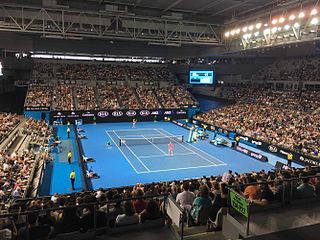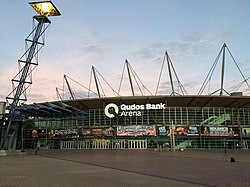
The Sydney Kings are an Australian men's professional basketball team competing in the National Basketball League (NBL). The team is based in Sydney, New South Wales, and play their home games at Qudos Bank Arena in Sydney Olympic Park. The Kings were formed from a merger between the West Sydney Westars and the Sydney Supersonics in October 1987. The Kings have won five NBL championships in 2003, 2004, 2005, 2022 and 2023. They were the first team to win three consecutive championships in the NBL and currently sit third behind Melbourne United (six) and the Perth Wildcats (ten) for championships won.

Rod Laver Arena is a multipurpose arena located within Melbourne Park, in Melbourne, Victoria, Australia. The arena is the main venue for the Australian Open, the first Grand Slam tennis tournament of the calendar year.

The Brisbane Bullets are an Australian professional men's basketball team in the National Basketball League (NBL) based in Brisbane, Queensland. They competed from 1979 to 2008, and returned to the league in 2016. Brisbane were one of ten NBL foundation teams and have won three NBL championships, being successful in the 1985 and 1987 seasons, and again in 2007. They have also competed in the 1984, 1986 and 1990 grand finals and have reached the playoffs 22 times.

Sydney Entertainment Centre, later known as Qantas Credit Union Arena, was a multi-purpose arena located in Haymarket, Sydney, Australia. It opened in May 1983, to replace Sydney Stadium, which had been demolished in 1970 to make way for the Eastern Suburbs railway line. The centre was owned by the Sydney Harbour Foreshore Authority, which administered the neighbouring Darling Harbour area, and managed under a lease.
The Brisbane Entertainment Centre is a multi-purpose indoor arena located in the Brisbane suburb of Boondall, Queensland, Australia. The centre is managed by ASM Global. The centre also houses a sporting complex and small function rooms which are available to hire for wedding reception and business functions.

The Derwent Entertainment Centre (DEC), known commercially as MyState Bank Arena since 2021, is Tasmania's largest indoor arena, serving as Hobart's primary location for large indoor sporting events, functions and live entertainment. Commissioned by the Tasmanian Government and the Glenorchy City Council, the DEC served as the home arena for the Hobart Devils in the NBL from 1989 until 1996, when the team's licence was revoked. Subsequently, between 1997 and 1998, ownership was transferred entirely to the City of Glenorchy, where it became a financial burden and incurred significant maintenance expenses for Glenorchy taxpayers, while seeing limited use. As the largest enclosed multipurpose venue in Tasmania, the DEC has hosted many Australian and international musical acts, including Kylie Minogue, Bob Dylan, Carole King, The Corrs, James Brown, Leonard Cohen, Tina Turner, Blondie and The Beach Boys.
The National Basketball League (NBL) is the premier professional men's basketball league in Australia and New Zealand. It was established in 1979. Andrew Gaze is widely considered one of the league's greatest players and features heavily in these records. Since its inaugural season he has had seven of the top ten seasons for average points scored. Gaze is also the league's highest career point scorer with 18,908. Statistics have been kept for both individuals and teams since its inception.

The Adelaide Entertainment Centre (AEC) is an indoor arena located in the South Australian capital of Adelaide. It is used for sporting and entertainment events. It is the principal venue for concerts, events and attractions for audiences between 1,000 and 11,300.

Spark Arena is a multipurpose arena in Auckland, New Zealand. The venue is located at Quay Park, Parnell, very close to Britomart Transport Centre and The Strand Station. The arena cost approximately $94 million, and of this sum ratepayers contributed $68 million for the facility to be managed by QPAM, the NZ operator, in New Zealand's first big public-private partnership. This runs for 40 years before ownership is transferred to the city.

Adelaide Arena is a multipurpose indoor sports stadium located in Findon, an inner western suburb of Adelaide, South Australia.

Hillsong Conference is a mid-year week-long annual Christian conference hosted in Sydney, Australia, with a smaller three-day event held in London later each year. It is the largest annual conference in Australia of any kind. The event is hosted by Hillsong Church at the Qudos Bank Arena and surrounding Olympic Park precinct.

The State Sports Centre is a multi-use indoor arena in Sydney, New South Wales, Australia and was opened in November 1984. With a total of 3,854 fixed and retractable seats the main arena is a focal point of the Sydney Olympic Park Sports Centre. An additional 1,152 portable seats can be accommodated on the floor level to bring seated capacity to 5,006.

The Sydney Olympic Park Tennis Centre is a tennis and multi-purpose sports facility in the Sydney Olympic Park suburb of Sydney, New South Wales, Australia. The centre was built in 1999 and hosted the tennis events for the 2000 Summer Olympics. The venue hosted the Sydney International tournament from 2000 to 2019, the Sydney Tennis Classic in 2022, the ATP Cup in 2020 and 2022, and the United Cup since 2023. The main stadium in the centre is the Ken Rosewall Arena, which has a seating capacity of 10,500, and is capable of hosting multiple sports, including tennis and netball.

Perth Arena is an entertainment and sporting arena in the city centre of Perth, Western Australia, used mostly for basketball matches. It is located on Wellington Street near the site of the former Perth Entertainment Centre, and was officially opened on 10 November 2012. Perth Arena is the first stage of the Perth City Link, a 13.5-hectare (33-acre) major urban renewal and redevelopment project which involves the sinking of the Fremantle railway line to link the Perth central business district directly with Northbridge.
Bendigo Stadium is an Australian sports and entertainment center in Bendigo, Victoria. The stadium is home to the Bendigo Braves (NBL1) and Bendigo Spirit (WNBL). It held basketball matches during the 2006 Commonwealth Games and would've held netball during the 2026 Commonwealth Games, but Victoria withdrew their hosting rights in 2023. The stadium's facilities include ten indoor sports courts, major exhibition and function areas, a licensed clubroom and associated administration facilities.
Qudos Mutual Limited, trading as Qudos Bank, is an Australian mutual bank that provides retail banking products and services, including home loans, personal loans, car loans, credit cards, savings, financial planning assistance, and foreign exchange.

John Cain Arena is a multi-purpose sports and entertainment arena located within Melbourne Park in Melbourne, Victoria, Australia. It is the second-largest venue and show court for the Australian Open, the first Grand Slam professional tennis tournament held each calendar year. The arena also hosts various other sporting and entertainment events throughout the year.

The South East Melbourne Phoenix are an Australian professional basketball team based in Melbourne, Victoria. The Phoenix entered the National Basketball League (NBL) in the 2019–20 season. The team play the majority of their home games at John Cain Arena, which they share with fellow NBL team Melbourne United, with some games being played at the State Basketball Centre.





















